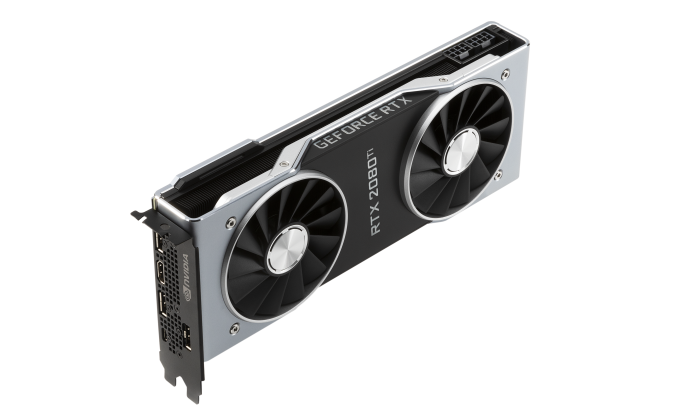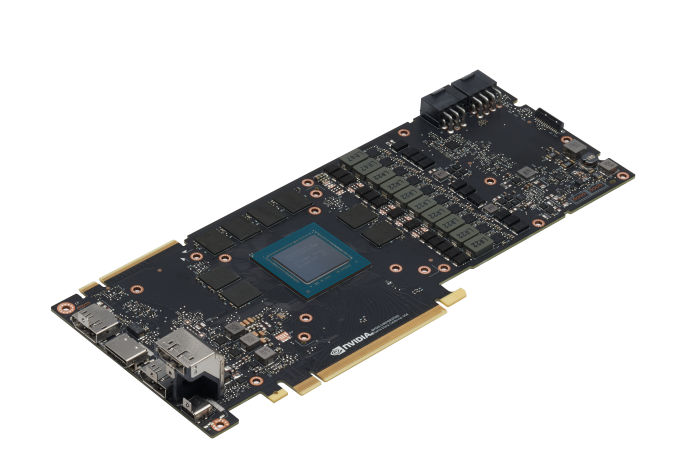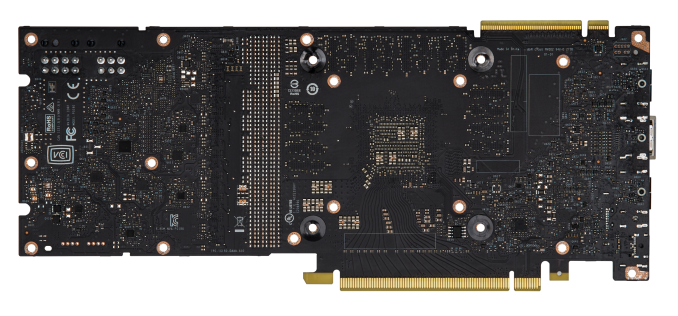The NVIDIA GeForce RTX 2080 Ti & RTX 2080 Founders Edition Review: Foundations For A Ray Traced Future
by Nate Oh on September 19, 2018 5:15 PM EST- Posted in
- GPUs
- Raytrace
- GeForce
- NVIDIA
- DirectX Raytracing
- Turing
- GeForce RTX
Meet The GeForce RTX 2080 Ti & RTX 2080 Founders Editions Cards
Moving onto the design of the cards, we've already mentioned the biggest change: a new open air cooler design. Along with the Founders Edition specification changes, the cards might be considered 'reference' in that they remain a first-party video card sold direct by NVIDIA, but strictly-speaking they are not because they no longer carry reference specifications.
Otherwise, NVIDIA's industrial design language prevails, and the RTX cards bring a sleek flattened aesthetic over the polygonal shroud of the 10 series. The silver shroud now encapsulates an integrated backplate, and in keeping with the presentation, the NVLink SLI connectors have a removable cover.
Internally, the dual 13-blade fans accompany a full-length vapor chamber and component baseplate, connected to a dual-slot aluminum finstack. Looking at improving efficiency and granular power control, the 260W RTX 2080 Ti Founders Edition features a 13-phase iMON DrMOS power subsystem with a dedicated 3-phase system for the 14 Gbps GDDR6, while the 225W RTX 2080 Founders Edition weighing in with 8-phases main and 2-phases memory.
As is typical with higher quality designs, NVIDIA is pushing overclocking, and for one that means a dual 8-pin PCIe power configuration for the 2080 Ti; on paper, this puts the maximum draw at 375W, though specifications-wise the TDP of the 2080 Ti Founders Edition against the 1080 Ti Founders Edition is only 10W higher. The RTX 2080 Founders Edition has the more drastic jump, however, with 8+6 pins and a 45W increase over the 1080's lone 8 pin and 180W TDP. Ultimately, it's a steady increase from the power-sipping GTX 980's 165W.
One of the more understated changes comes with the display outputs, which thanks to Turing's new display controller now features DisplayPort 1.4 and DSC support, the latter of which is part of the DP1.4 spec. The eye-catching addition is the VR-centric USB-C VirtualLink port, which also carries an associated 30W not included in the overall TDP.
Something to note is that this change in reference design, combined with the seemingly inherent low-volume nature of the Turing GPUs, cuts into an often overlooked but highly important aspect of GPU sales: big OEMs in the desktop and mobile space. Boutique system integrators will happily incorporate the pricier higher-end parts but from the OEM’s perspective, the GeForce RTX cards are not just priced into a new range beyond existing ones but also bringing higher TDPs and no longer equipped with blower-style coolers in its ‘reference’ implementation.
Given that OEMs often rely on the video card being fully self-exhausting because of a blower, it would certainly preclude a lot of drop-in replacements or upgrades – at least not without further testing. It would be hard to slot into the standard OEM product cycle at the necessary prices, not to mention the added difficulty in marketing. In that respect, there is definitely more to the GeForce RTX 20 series story, and it’s somewhat hard to see OEMs offering GeForce RTX cards. Or even the RT Cores themselves existing below the RTX 2070, just on basis of the raw performance needed for real time ray tracing effects at reasonable resolutions and playable framerates. So it will be very interesting to see how the rest of NVIDIA’s product stack unfolds.
















337 Comments
View All Comments
Billstpor - Friday, September 21, 2018 - link
Wrong. It's already known that the tensor cores have enough juice to run ray-traced effects and DLSS at the same time:https://youtu.be/pgEI4tzh0dc?t=10m55s
Vayra - Monday, September 24, 2018 - link
Wrong, the tensor cores need DLSS to run ray tracing at somewhat bearable FPS - that is, 30 to 60.DLSS is a way to reduce the amount of rays to cast.
Vayra - Monday, September 24, 2018 - link
Hence the non-existant improvement, or even worse position in terms of quality compared to SSAA x4 or better.In other words, running at native 4K is miles sharper and will perform miles better than a DLSS+RTRT combination still.
IUU - Sunday, September 23, 2018 - link
While your argument is solid, these days are just so weird that even $1200 cards seem to make a hell of a lot sense. This is also valid for similar desktop cpus.Why? Well , go buy a high-end iphone or a high end android phone... Enough said.
PS. For those who may use arguments like geekbench and such , it is just insulting to put it very very kindly!
Gastec - Thursday, September 27, 2018 - link
So basically buying high-priced electronics make sense because the companies selling them just increase the prices every year to make profits and a certain type of consumers are supporting those companies by purchasing no matter what the price (call them fanbois). The question is: Why, why are those people acting like that? What drives them?watek - Wednesday, September 19, 2018 - link
Consumers paying these premium prices for features that are not even fully developed or finished is mind boggling!! People are being bent over and screwed by Nvidia hard yet they still pay $1500 to be beta testers until next Gen.V900 - Wednesday, September 19, 2018 - link
Mindboggling? I suppose it would be for a time traveller visiting from the 19th century, but for everyone else it’s perfectly normal.There is always a price premium for those early adopters who want to live on the cutting edge of technology.
When DVD players came out, they cost over a 1000$ and the selection of movies they could watch was extremely small. When Blu-ray players came out, they also cost well over 1000$ and the entire catalogue of Blu-ray titles was a dozen movies or so.
And keep in mind, that the price that Nvidia charges for joining the early adopter club is really shockingly low.
When OLED or 4K televisions first came out, people paid tens of thousands of dollars for a set, and the selection of 4K entertainment to watch on them was pretty much zero.
With the 2080, early adopters can climb aboard for 600-1000$.
Games that take advantage of DLSS and RTX will be here soon and in the meantime they have the most powerful graphics card on the market that will play pretty much anything you can throw at it, in 4K without breaking a sweat.
It’s not a bad deal at all.
imaheadcase - Wednesday, September 19, 2018 - link
Again, two technology that have not even seen the real light of day, let alone to be proven worth it at all. Early adopters of the other techs you listed at least got WORKING TECH from the start as promised.V900 - Wednesday, September 19, 2018 - link
Ok, you’re either deliberately spreading untruths and FUD, or you just haven’t paid attention.There are games NOW that support RTX and DLSS. Games like Shadow of the Tombraidet, Control and PUBG.
And there are more games coming out THIS YEAR with RTX/DLSS support: Battlefield 5 is one of them.
The next Metro is one of many games coming out in early 2019 that also support RTX.
So tell me again how this is different from when Blueray players came out?
imaheadcase - Wednesday, September 19, 2018 - link
THose games you listed don't have it now, they are COMING. lol Even then the difference is not even worth it considering the games don't hardly take a hit for the 1080TI. You are the nvidia shill on here and forums as everyone knows.